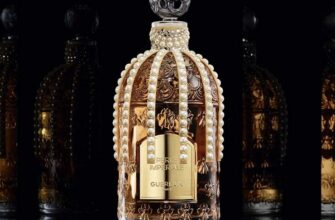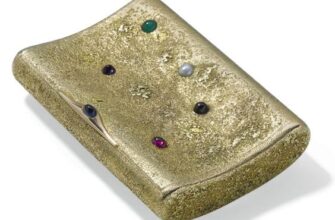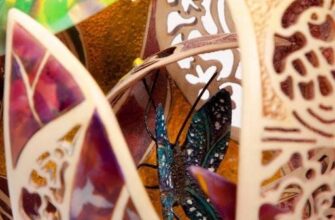A necklace is a neck ornament that can take on a variety of forms - beads, collars, necklaces, chokers, collars, monistos, pendants and pendants. Necklaces were extremely popular because of where they were worn. Located "on the facade" of the person, they advertised the wealth of the owner. They also had protective properties, tk. necklaces cover the neck, jugular fossa, chest - rather vulnerable places on the human body. The owners often took them with them to the afterlife. Neck decorations play an important role in the funeral cult, for example, the same ancient Egyptian pectorals.
Necklaces from the "Game of Thrones"
Melisandre's necklace
In addition to the protective and "advertising" function, necklaces also have a stabilizing, fastening, as these decorations represent diversity in unity. Multiple and sometimes different elements of the necklace are strung on one thread / chain, which symbolizes the hidden essence and the connection of different parts. All this further enhances the magical essence of this type of jewelry.
Melisandre's necklace (choker) is a good example of such a magical talisman. It allows the priestess to maintain the appearance of youth and hides her true nature. A choker holds her decrepit, almost decayed body together. After the siege of Winterfell by the undead, Melisandre removes her necklace and quickly crumbles to dust.

The necklace is a chain of metal hexagonal links with ruby in the middle of the composition. In medieval sources, the ruby was endowed with the power of all stones, in particular, healing and restoring. In addition, the ruby is associated with fire, so the choice of this stone for the priestess of the fiery god is quite understandable.
In turn, the hexagonal element underlying the necklace is taken from the design of the openwork mask of the shadow caster Quaita, whom Daenerys met in Qarth. Like Melisandre, Quaita comes from Asshai, hence the similar solutions in products, designed to emphasize belonging to one culture.
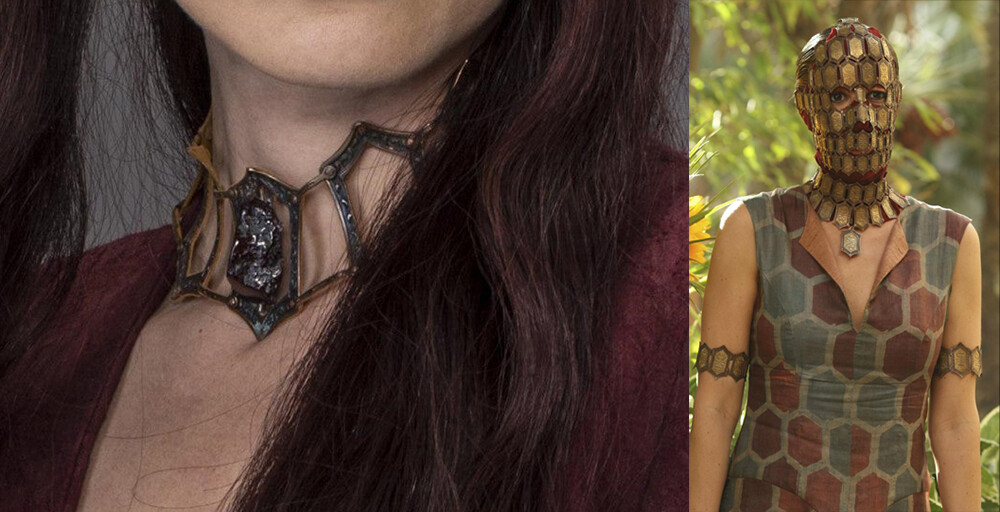
And the design of the mask is borrowed from the autumn 2009 collection of Alexander McQueen.

Cersei's necklace
In the Game of Thrones series, it is extremely interesting to watch the transformation of the characters expressed in their costumes, to read the visual cues as the characters evolve. Cersei Lannister is one of the most curious characters in this regard. From a "bird in a cage" in the shadow of her indefatigable husband King Robert, Cersei gradually gains independence, confidence and power. From time to time she rolls back, now shackled by the growing uncontrollability of the son of King Joffrey, then the decisive actions of the father Tywin Lannister, then her image softens again. But in general, there has been a noticeable increase in the number of metal accessories in Cersei's costume, from metal belts and corsets to knightly shoulder pads and aiguillette chains in recent seasons.
During the confrontation between Cersei and the young Queen Margery, who relies on her youth, beauty and charm, a massive gold necklace adorned with lions appears on the first one. With his help, Cersei seems to protect herself from the growing influence of Margery and demonstrates her determination and firmness in maintaining her status and existing power. And of course, once again to emphasize who is the main Lannister here.

Sansa's pendant
Resembling a belt buckle, Sansa Stark's round pendant is not as simple as it seems at first glance, and is fraught with a lot of meaning. According to series costume designer Michelle Clapton, the circle is a symbol of security and unity, and the sharp element hanging at the end of the chain is Arya's sword, the Needle, as well as the needle of the skilled needlewoman, Sansa herself. The partition becomes a symbol of their connection, community. And the chain is an indication of the difficult fate of Sansa, her submission to either the Lannisters, or the Littlefinger, or the Boltons.
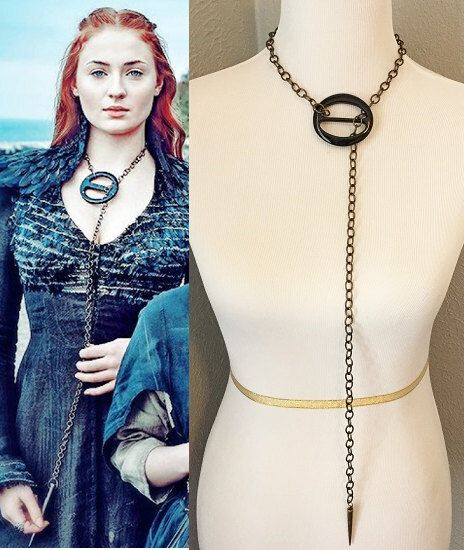
Chains of Maesters
Maesters, "knights of the mind", the most learned people of the Seven Kingdoms, serve as mentors, advisers and the main custodians of knowledge. They wear chains around their necks that distinguish them from other citizens and confirm their qualifications in various fields. Each maester's chain is made up of links made from different metals, each symbolizing something.
What do the different metals represent? For example, gold is mathematics and finance, silver is medicine, cast iron (black iron) is the training of ravens, lead is the knowledge of poisons, bronze is astronomy and astrology, copper is history, iron is military affairs, dull steel is blacksmithing, Valyrian steel - magic (a rare link, because the study of magic is not encouraged by the order of meisters). In total, fifteen metals are named in the books, but there may be more links in the chain (according to some sources, up to 21 according to the number of archmaesters in the Conclave and their disciplines). Also, several links of the same metal can be present in the meister chain, showing a particularly deep knowledge in this area.
The chain represents the kingdom, for just as maesters accumulate knowledge in different areas of knowledge, so the kingdom needs a variety of classes and specialties. In general, chains can be considered both an ornament and a badge of distinction. However, maesters treat their badges of honor differently - some flaunt the chain like Maester Pycelle, others modestly wear it under their clothes like Maester Luwin. Maester Aemon did not take off his chain even at night, for the coming sleep.

According to the books, archmaesters have other accessories besides the chain, which represent the areas of expertise in which they specialize. This is a ring, a scepter and a mask.
Necklaces and pendants from The Lord of the Rings and their prototypes
Brisingamen
The legendary decoration of the beautiful goddess Freya from Scandinavian myths, the Brisingamen was either a necklace (or torque) or a belt.
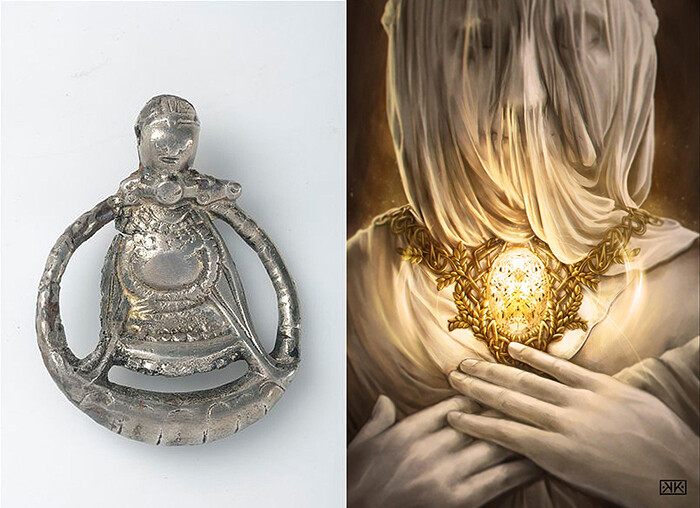
The origin of the name is unclear. Either it means the necklace of the Brisings, or it goes back to the old Norse poetic form of the concepts "fire" and "amber", then it is a "sparkling/solar necklace". In general, both epithets apply to him. The necklace does not have any magical properties, it is just very beautiful, according to another version, it makes the wearer even more beautiful, but then it is not clear why Freya needed it, who was already the most beautiful of all people and goddesses. Somehow, Freya got the necklace from the Brising dwarves. The necklace was stolen by Loki, was borrowed by Thor, became the cause of the war ... And besides, it served as sources of inspiration for the storytellers of the following eras.
In particular, it was Brisingamen who served as the prototype for the Nauglamir necklace in Tolkien's The Silmarillion, and Ursula Le Guin retold the legend of Brisingamen in her first science fiction novel, The Planet of Rocannon. Brisingamen can also be found in games such as Ragnarok Online and Castlevania: Lament of Innocence.
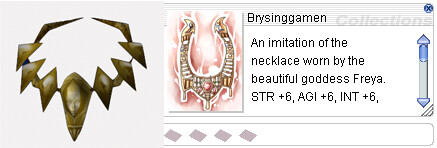
Nauglamir
Not only is this necklace the pinnacle of Dwarf jewelry, it also has the honor of setting one of the greatest jewels in Tolkien's legendarium - one of the three Silmarils, the most beautiful stones in the history of Middle-earth. In shape, it was a karkanet (from French - collar) - a massive decoration, a wide chain with large stones, which fit snugly around the neck. Such necklaces were quite popular in the Middle Ages and the Renaissance (in Tudor England they were transformed into thinner and more elegant chains), and then they came back into fashion in the Victorian era.

The Nauglamir was a special decoration. It "hidden such strength that it easily lay on the chest, like a linen strand, and no matter who put it on the neck, it always looked beautiful and elegant." Commissioned by the Elven King Finrod Felagund, this piece of jewelry was made using stones provided by him from the Undying Lands, making it even more special. After the destruction of Nargothrond, the necklace came to King Thingol, who decided to combine it with the Silmaril. This stone, having absorbed the light of the Two Trees of Valinor, languished for a long time in the crown of Morgoth, until Beren and Lúthien brought it back, thus accomplishing a great feat.

The Dwarves of Nogrod did this work, and the Nauglamir became even more beautiful, and its many stones reflected the radiance of the Silmaril. The necklace was so successful that the dwarves refused to return it. They said that it was their ancestors who created the jewelry, and therefore it belongs to them by right. The ensuing massacre put an end to good neighborly relations between elves and dwarves. As a result, the necklace went to Beren and Lúthien, after their son Dior, granddaughter Elwing, and finally her husband Earendil. Here traces of the Nauglamir are lost - it is not known whether the Silmaril received a new setting or Eärendil took him with a necklace to his heavenly guard.
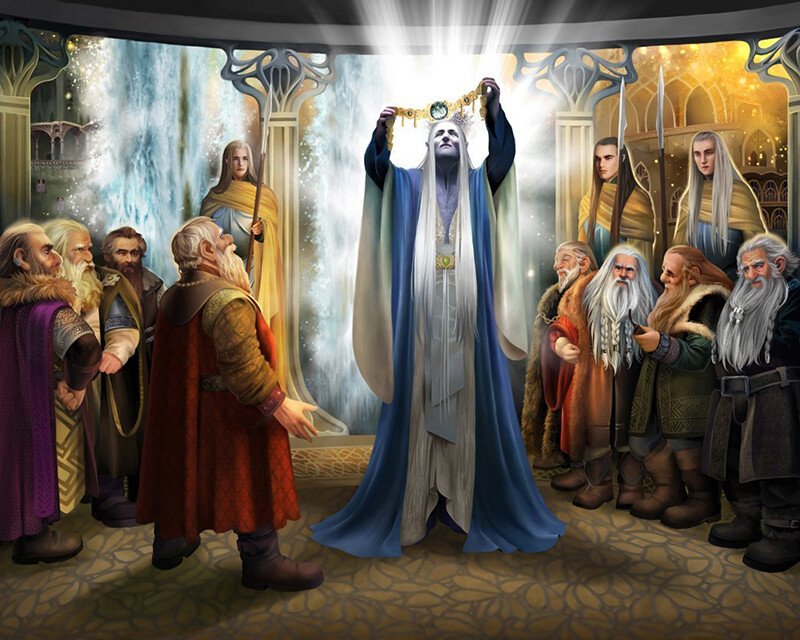
Evening Star Light
Another pendant has a truly amazing fate. It was invented for the film, there was no such decoration in the book, and it became so popular that it turned into a kind of independent symbol of love and fidelity, an icon that separated from the work for which it was created. We are talking about Arwen's pendant - "Light of the Evening Star".
The stunning eye-catching design of the piece was designed by renowned New Zealand jeweler Jasmine Watson. Jasmine says that Arwen's pendant took the most time to develop and was the most complex piece of work she created for the film. "Light of the Evening Star", symbolizing the very essence of Arwen and her incomparable beauty, was supposed to convey a sense of the power of mind and magic inherent in the princess of the elves.
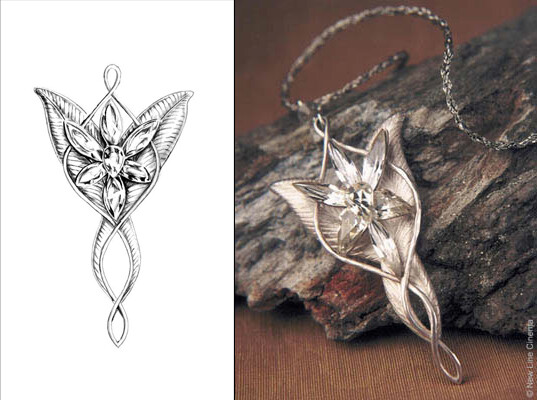
Arwen gave Aragorn her jewelry as a token of her feelings. This special gift from an immortal elf to a mortal human symbolized the princess's decision to forgo immortality in order to be with the person she truly loves. The meaning of the pendant quickly made it a popular piece of jewelry to give as a gift to express your feelings.
Exquisite celestial design of seven sparkling crystals arranged like a flower in a finely engraved and openwork silver setting in the shape of either a butterfly or art nouveau intertwined petals and leaves make this magnificent pendant a truly magical gift - both in the film world and in the real world. the world.
Elessar
In the book version of The Lord of the Rings, instead of the Light of the Evening Star, Arwen gives Aragorn a completely different object - the green elven stone Elessar (Aragorn was later crowned under the same name), placed in a silver frame in the form of an eagle with outstretched wings. This stone (beryl), according to legend, was created by Celebrimbor in the second age for Galadriel and possessed magical powers that made the possessions of Lorien the most beautiful in the world.
However, she gave the stone to her daughter Celebrian (Arwen's mother) after she received Nenya's ring. So Arwen inherited it - and returned it to her grandmother Galadriel, so that she would give the stone to Aragorn. Galadriel gave the Elessar to Aragorn in Lothlórien as a symbol of hope for rebirth.
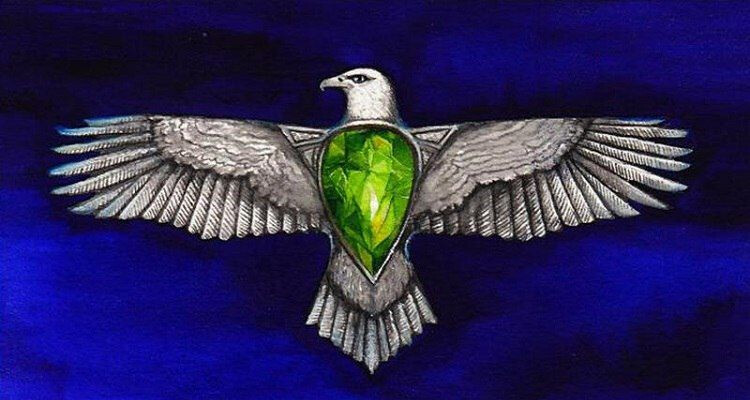
There was also a second Elessar, more ancient. It came from Gondolin, where it belonged to King Turgon's daughter Idrili, who passed it on to her son Eärendil. Created by the elven master Enerdil, it shone brighter than the stone of Celebrimbor, for Enerdil created his stone when the Sun was still young, and when Celebrimbor took up his work, many years had passed, and the light of Middle-earth was dimmed, since the shadow of Morgoth still lay on Arda . However, the Elessar of Celebrimbor gave off a wondrous radiance, like the sun shining through the leaves of the trees. Through the stones, one could see everything withered and decayed as it was in the bloom of youth, and the hands of the owner of the stone brought healing to everyone they touched.
Medallions in different subjects
Eye of Agamotto
Ancient Egyptians, Greeks and Iranians, Muslims, Hindus, Buddhists - in many religions there are sacred eye signs and amulets associated with them (suffice it to recall the Egyptian eye of Horus, the Turkish Nazar bonjuk, popular with tourists, or the All-Seeing Eye, which gained special fame thanks to the Masons).
Focusing on the all-seeing eye of the Buddha (the amulet is known among Buddhists as the "Snail Martyr Amulet"), Stan Lee and Steven Ditko created a magical artifact for the Marvel comics universe called the Eye of Agamotto. This amulet is associated with Doctor Strange, who has learned to control his powers and wears it on his chest.
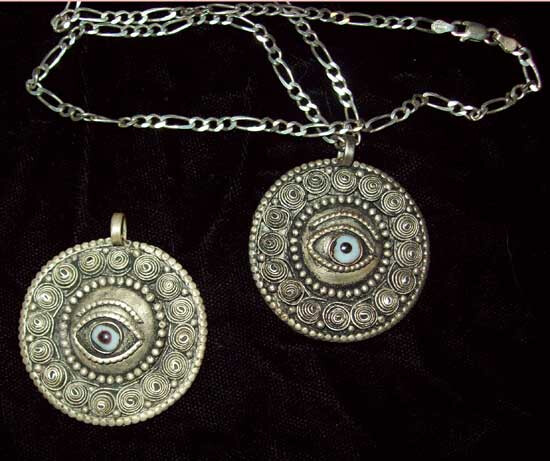
A powerful relic created by Agamotto, the first Grand Enchanter, to store and harness the power of the time hidden within the Stone, has long been passed down through the lineage of the Grand Enchanter. The history of the artifact in the comics and the Avengers movie series is different, but everywhere this thing has great magical potential - the amulet is able to dispel illusions, weaken dark entities, create portals and, of course, control time.
The design of the amulet as an element of props during filming has undergone significant changes. According to Barry Gibbs, prop designer at Marvel's art department, the original concept has been completely redesigned (by props). Only one stone inside the amulet was matched through 24 variations of green color!
In the film, the lighting varies from scene to scene, somewhere the stone lacked light and was lost. And in some scenes, the amulet had to be open, not to interfere with the buttoning of the magical cloak (another iconic element of the Doctor's wardrobe) and the imposition of computer special effects - all these conditions affected every element of the design.
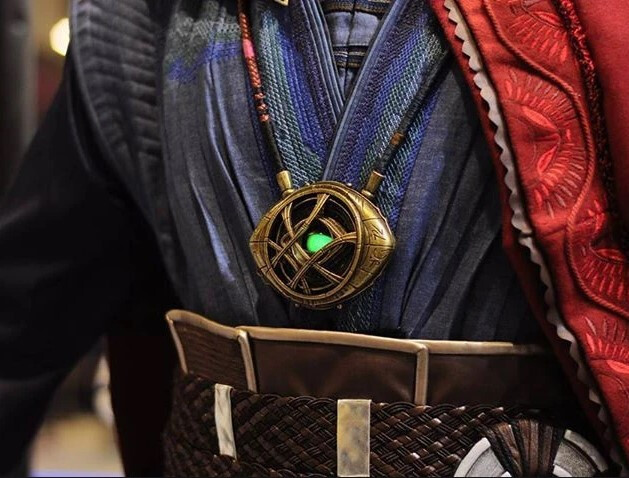
Even the materials themselves were recycled - for some copies of the amulets, the designers rejected 3D printing, because. in this form, it seemed too massive when shooting (therefore, bronze and brass were used for the master form). The stone was meant to look like real natural stone when it didn't glow on its own. Finally, the glowing prop element on Strange's chest should not have been associated with the glowing reactor in Iron Man's chest. As a result, the masters managed to create a truly memorable supernatural artifact, which, moreover, serves as an excellent decoration for the image of Doctor Strange.

Medallion Slytherin
This ancient jewel from the world of Harry Potter had a grim fate to become one of the Dark Lord's Horcruxes (and, accordingly, a series of death and suffering stretches behind). Initially, the relic belonged to Salazar Slytherin, and later to his descendants from the Gaunt family. After turning into the receptacle of a particle of the soul of Voldemort, the medallion was securely hidden on an island in the middle of an underground lake teeming with infernals.
Like the ring of Omnipotence, the horcrux caused various negative effects in the wearer (unless, of course, he himself was related to the dark essence enclosed inside, such as Dolores Umbridge). The medallion caused severe depression, loss of strength, disbelief in oneself and in the success of the common cause. Ron Weasley suffered the most from his exposure. It is all the more remarkable that it was he who destroyed the Horcrux.
In the books, the Slytherin locket is described as a large, heavy, oval locket with a serpentine "S" and encrusted with green stones, but in the films, the locket is shown as a relatively small, octagonal silver medallion with a gold front adorned with either faceted glass or an unknown greenish a stone, in the depths of which the letter "S" is visible.
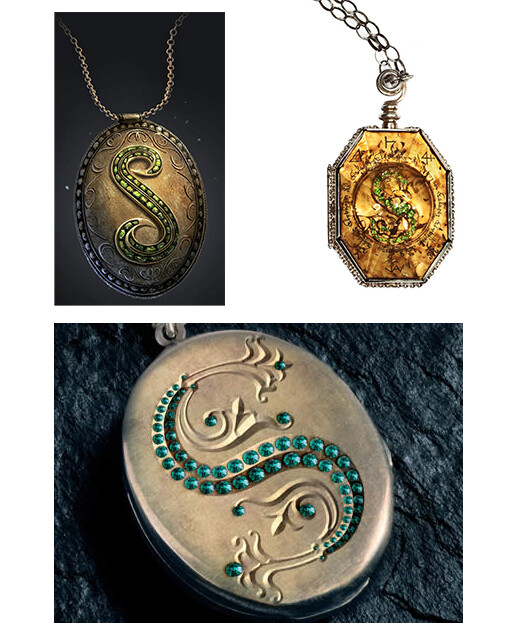
The movie version of the medallion is similar to the amber skull ring from Thief. And this is not surprising, because the design of both jewelry is inspired by the mourning theme, so relevant for the real Victorian era (Queen Victoria wore mourning for her untimely deceased husband for many decades).

In this form, the medallion could hardly have belonged to Salazar Slytherin, who lived in the distant Middle Ages (except perhaps the stone itself, in a different setting), so it can be assumed that creating the right mood through mourning associations with the Victorian era was more important to the production designers of the film version than the exact historical match.
How to choose jewelry for Princess Leia from Star Wars
In the spring of 1976, a telephone rang in the workshop of the then little-known Finnish jeweler Bjorn Wekström. Someone invited the designer to participate in the creation of jewelry for the new film. At the time, Wekström had no idea what a turning point for his career this event would turn out to be. No details were revealed, only a hint of science fiction. Wekström already had a space theme in his work, and the project seemed interesting to him. But who would have thought that it was about perhaps the most popular science fiction film in the history of cinema - Star Wars, and on the other end of the tube was the secretary of George Lucas.

The catch, alas, was that the jewelry was needed in a week, so it was decided to use the already available Space Silver collection from Lapponia. Only a year after the premiere of the picture in Finland on December 16, 1977, Vekström realized what he had become a part of ... One of the designer's friends recognized Vekström's jewelry worn by Princess Leia during the final scene of the very first film of the space saga: they were now easily recognizable " Planetary Valleys" and bracelet "Darina's Jewelry". To the delight of fans and aesthetes, these products are still available for purchase in the current Lapponia collection.
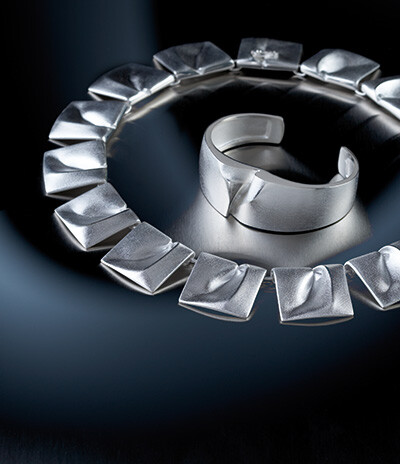
Royal Ruby of Stormhold
The Royal Ruby of Stormhold belongs to the royal family of the same name and has a special power. When the king of Stormhold was on the verge of death, he launched a stone into the sky on a mission to find the true heir to the throne among the four surviving princes.
Ruby soared into space and turned into a bright white comet that invaded the part of the sky where the stars lived. The comet hit a star and turned into a diamond-like gem. Lady Yvaine used it as a necklace. The stone turned red again and became a ruby when it was touched by the true heir, Tristan Thorne.
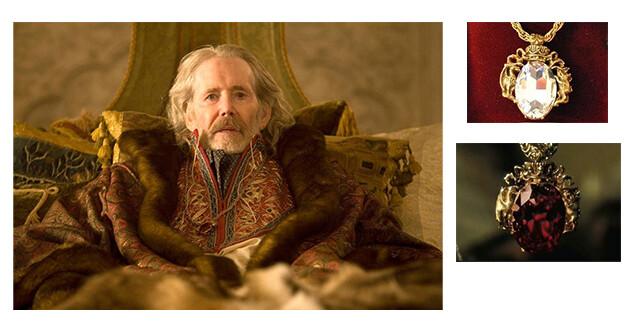
This fact is quite symbolic, because the ancient people believed that the ruby is a stone that accompanies power and might, power and spiritual fire. Often it is used as a symbol of passionate and passionate love. It was believed that the ruby gives the owner the strength of a lion, the fearlessness of an eagle and the wisdom of a snake. The lion and eagle can be seen in the design of this royal decoration.
flying stone
The flying stone is a "magic" talisman, which is also the key to something more. In this case, to the legendary island-fortress Laputa (an allusion to Gulliver's Travels by J. Swift).
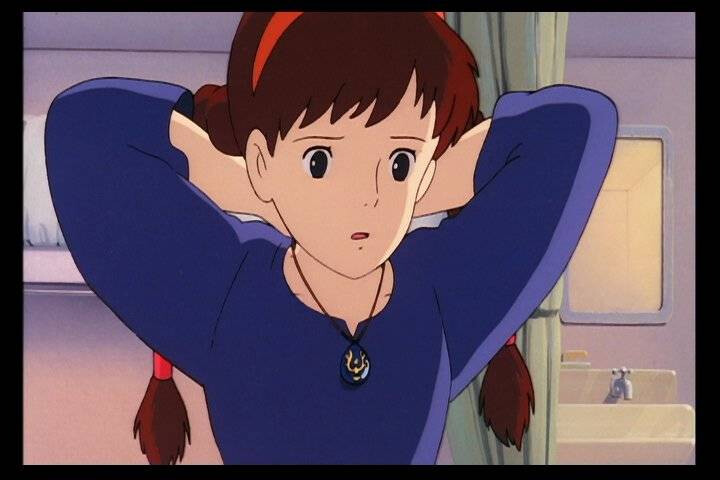
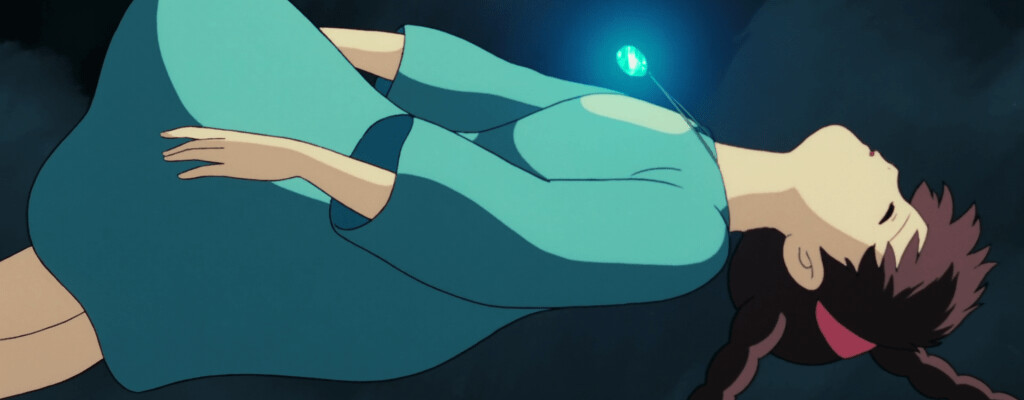
According to legend, this fortress is either a super weapon or an incredible treasure trove. Competitors do not give up hope to take possession of the talisman and a real hunt begins (as it should be!) for it. A simple-looking pendant with a bluish crystal on a chain can do a lot of things!
"Ocean heart"
One of the highlights of James Cameron's Oscar-winning film Titanic is the posing of the young beauty Rose Dawson for the romantic artist Jack. A naked body adorned only with a pendant with a large blue heart-shaped stone is a memorable combination.

According to the film, this stone once belonged to Louis 16, and acquired the shape of a heart after the French Revolution. In fact, this decoration is made of blue tanzanite framed in white gold and framed in cubic zirconia. Asprey & Garrad designed this piece for approximately $3000. But after the enormous success of the picture, an order was received to create the "Heart of the Ocean" from real gems. This is how a heart-shaped sapphire weighing 171 carats was born, with a frame of 103 diamonds worth almost one and a half million dollars. Celine Dion even spoke about this at the Oscars in 1998.
It is believed that the real prototype of the "Heart of the Ocean" is the famous Hope Diamond worth $ 250 million (the most expensive small item in the world), donated to Louis 16. Subsequently, the stone changed many owners until it reached the banker Henry Philip Hope, whose name it was named. After the Hope family, the diamond was in the hands of jewelers Pierre Cartier and Harry Winston. The latter donated the blue masterpiece to the Smithsonian Institution, where it remains to this day.
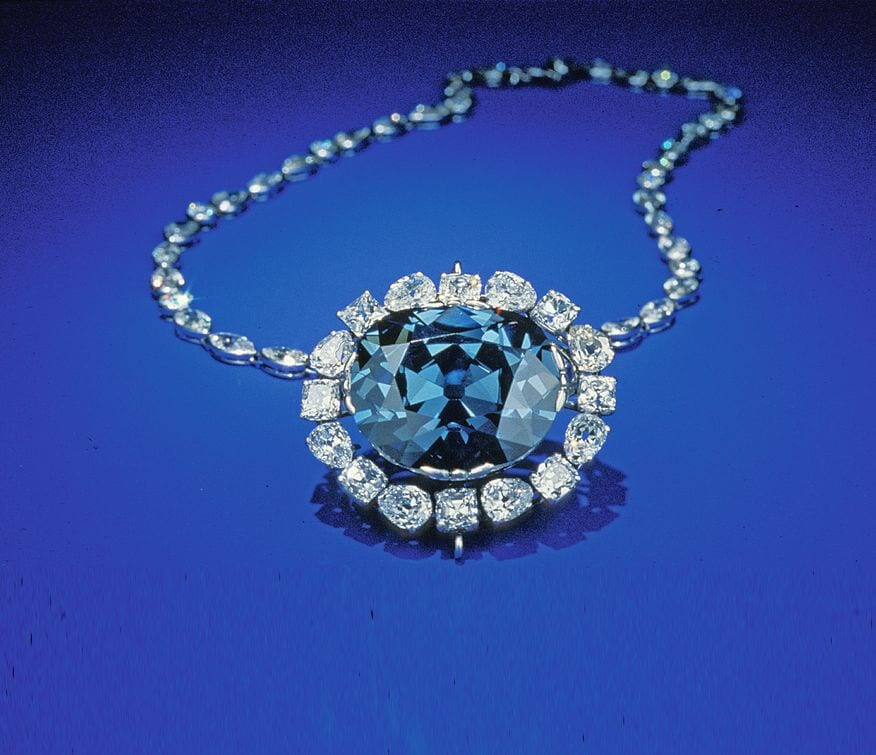
There was a rumor about this stone as fatal, bringing misfortune. Allegedly, everyone who owned it was either killed or died under mysterious circumstances. The legend of the curse originates in India, where a 115-carat diamond was mined that adorned the statue of the goddess Sita - from which the famous cursed stone, brought to Europe along with the plague, would later be obtained ...

Talisman of Balance
The Talisman of Balance in The Longest Journey is an ancient talisman that has been kept in the Sentinel Enclave for the past ten thousand years in anticipation of the day when the Thirteenth Guardian of the Balance will appear. In 2209, the talisman was given to April Ryan by the vestrum Tobias of Marcuria when he mistakenly thought April was the new Guardian. This is a powerful magical artifact that can affect other magical objects and entities. For example, with its help, April managed to subdue and imprison a huge whirlwind of chaos inside the talisman.
Given that the game is made in Norway, it's easy to feel the Nordic touches in its aesthetics. The pattern on the talisman, as well as the stone carvings in the Tower of the Guardian, testify to the influence of the northern ancestors of the Norwegians, the Vikings. The asymmetric, curved nature of the “balance emblem” can be correlated with the decor applied to brooches, runic stones, and sides of longships. In general, there are a lot of Viking styles, they are named after the places of archaeological finds. Broa's style might be assumed here. A characteristic feature of the Broa style is the image with an uneven thickness of wavy lines, uneven asymmetrical figures, the asymmetry of the ornament, enclosed in a symmetrical "geometrically correct frame".
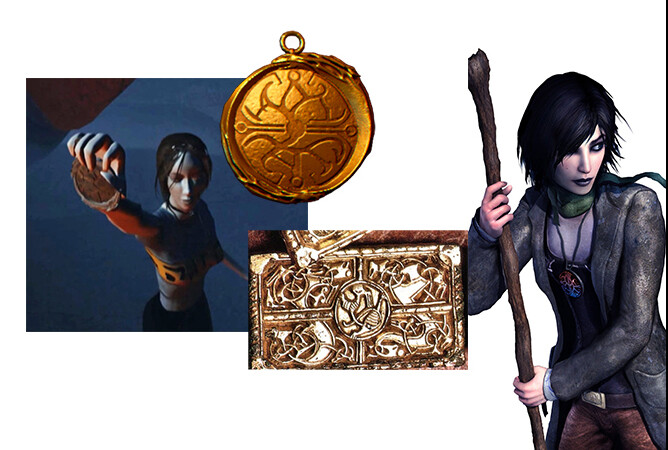
In the sequels of the game, it is difficult to tell if the medallion April wears is a visually altered version of the same talisman, or if she hides the original talisman under her clothes. The further fate of the medallion is unknown - it is again found in the House of All Worlds with Lady Alvani.

